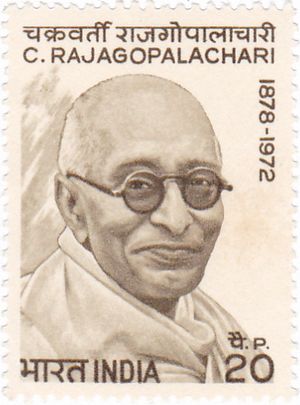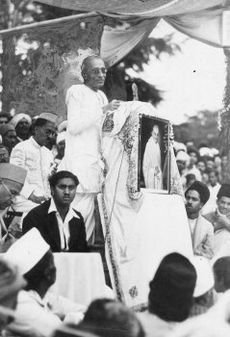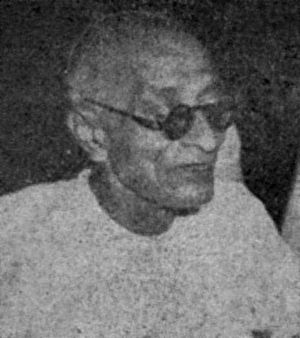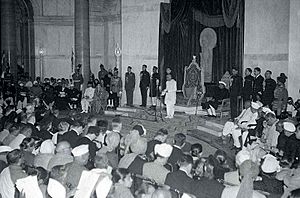C. Rajagopalachari facts for kids
Quick facts for kids
C. Rajagopalachari
|
|
|---|---|

C Rajagopalachari commemorative stamp
|
|
| Governor-General of India | |
| In office 21 June 1948 – 26 January 1950 |
|
| Monarch | George VI |
| Prime Minister | Jawaharlal Nehru |
| Preceded by | Louis Mountbatten |
| Succeeded by | Rajendra Prasad as President of India |
| Minister of Home Affairs | |
| In office 17 December 1950 – 5 November 1951 |
|
| Prime Minister | Jawaharlal Nehru |
| Preceded by | Vallabhbhai Patel |
| Succeeded by | Kailash Nath Katju |
| Minister without portfolio | |
| In office 15 July 1950 – 17 December 1950 |
|
| Prime Minister | Jawaharlal Nehru |
| 1st Governor of West Bengal | |
| In office 15 August 1947 – 21 June 1948 |
|
| Premier | Prafulla Chandra Ghosh Bidhan Chandra Roy |
| Preceded by | Position established Frederick Burrows as Governor of Bengal Presidency |
| Succeeded by | Kailash Nath Katju |
| 2nd Chief Minister of Madras State | |
| In office 10 April 1952 – 13 April 1954 |
|
| Preceded by | P. S. Kumaraswamy Raja |
| Succeeded by | K. Kamaraj |
| 8th Premier of Madras Presidency | |
| In office 14 July 1937 – 9 October 1939 |
|
| Governor | The Lord Erskine |
| Preceded by | Kurma Venkata Reddy Naidu |
| Succeeded by | Tanguturi Prakasam |
| Constituency | Leader of the State Legislative Council |
| Personal details | |
| Born |
Chakravarti Rajagopalachari
10 December 1878 Thorapalli, Madras Presidency, British Raj (now Thorapalli, Tamil Nadu, India) |
| Died | 25 December 1972 (aged 94) Madras, Tamil Nadu, India (present-day Chennai) |
| Resting place | Mootharignar Rajaji Ninaivaalayam |
| Nationality | |
| Political party | Swatantra Party |
| Other political affiliations |
Indian National Congress (Until 1957) Indian National Democratic Congress (1957–1959) |
| Spouse |
Alamelu Mangalamma
(m. 1897; died 1916) |
| Relations | Mahatma Gandhi (co-father-in-law) |
| Children | 5, including C. R. Narasimhan and Lakshmi Gandhi |
| Alma mater | Bangalore University Presidency College, Chennai |
| Profession |
|
| Awards | Bharat Ratna (1954) |
| Signature | |
| Writing career | |
| Language |
|
| Notable works | Chakravarti Thirumugan (Ramayana) Vyasar Virundhu (Mahabharata) Stories for the Innocent Hinduism; Doctrine and Way of Life |
| Notable awards | Sahitya Akademi Award |
Chakravarti Rajagopalachari (10 December 1878 – 25 December 1972), often called Rajaji or C.R., was an important Indian leader. He was a statesman, writer, lawyer, and activist who fought for India's freedom. Rajagopalachari was the last Governor-General of India, serving until India became a republic in 1950. He was also the only Indian-born person to hold this high position.
He led the Indian National Congress party and served in many important roles. These included Premier of the Madras Presidency, Governor of West Bengal, and a Union Minister. He also became the Chief Minister of Madras State. Rajagopalachari later started his own political party, the Swatantra Party. He was one of the first people to receive India's highest civilian award, the Bharat Ratna. He strongly believed in world peace and was against nuclear weapons. People sometimes called him 'Mango of Salem'.
Rajagopalachari was born in Thorapalli village in Tamil Nadu. He studied at Central College and Presidency College, Madras. In the early 1900s, he became a lawyer in Salem. He joined the Indian National Congress and became a close helper of Mahatma Gandhi. He took part in many protests against British rule, like the Non-cooperation movement and the Civil Disobedience movement. In 1930, he led the Vedaranyam Salt Satyagraha, a protest similar to Gandhi's Dandi March.
In 1937, Rajagopalachari became the Prime Minister (Premier) of the Madras Presidency. He held this role until 1940. After India gained independence, he served as Governor of West Bengal (1947-1948) and then as Governor-General of India (1948-1950). He also served as a Union Home Minister (1951-1952) and Chief Minister of Madras state (1952-1954). In 1959, he left the Indian National Congress and founded the Swatantra Party. He passed away on 25 December 1972, at the age of 94.
Rajagopalachari was also a talented writer. He wrote many books in both Tamil and English. He supported movements to stop alcohol use and allow all people, including Dalits, to enter temples. He was sometimes criticized for making Hindi a compulsory language in schools and for his education policy. Mahatma Gandhi called him the "keeper of my conscience."
Contents
- Early Life and Family
- Fighting for India's Freedom
- Premier of Madras Presidency (1937–1939)
- World War II and Later Roles
- Governor of West Bengal (1947–1948)
- Governor-General of India (1948–1950)
- In Nehru's Cabinet
- Chief Minister of Madras State (1952–1954)
- Leaving Congress and Forming Swatantra Party
- Anti-Hindi Protests (1965)
- 1967 Elections
- Later Years and Death
- Contributions to Literature and Music
- Legacy and Impact
- Images for kids
- See also
Early Life and Family
Rajagopalachari was born on 10 December 1878, in Thorapalli village. His parents were Chakravarti Venkatarya Iyengar and Singaramma. His father was a village officer. His family belonged to a Hindu Tamil Brahmin group.
As a child, Rajagopalachari was often sick. He went to a village school in Thorapalli. At age five, his family moved to Hosur, where he continued his schooling. He finished high school in 1891 and graduated from Central College in 1894. He then studied law at Presidency College, Madras, finishing in 1897.
In 1897, Rajagopalachari married Alamelu Mangalamma. They had five children: three sons (C. R. Narasimhan, C. R. Krishnaswamy, and C. R. Ramaswami) and two daughters (Lakshmi Gandhi and Namagiri Ammal). His wife, Mangamma, passed away in 1916. Rajagopalachari then raised his children by himself. His son, C. R. Narasimhan, later became a Member of Parliament. Rajagopalachari's daughter, Lakshmi, married Devdas Gandhi, who was Mahatma Gandhi's son.
Fighting for India's Freedom
Rajagopalachari became interested in public affairs and politics when he started his law practice in Salem in 1900. At 28, he joined the Indian National Congress party. He became a member of the Salem municipality in 1911 and its chairman from 1917 to 1919. During this time, he helped elect the first Dalit member to the Salem municipality. In 1917, he defended an independence activist against charges of rebellion. He also joined protests against the Rowlatt Act in 1919.
After Mahatma Gandhi joined the independence movement in 1919, Rajagopalachari became one of his closest followers. He stopped his law practice to join the Non-Cooperation movement. In 1921, he became the General Secretary of the Congress party. He strongly opposed working with the British government in the new legislatures. He also supported the Vaikom Satyagraha movement (1924–25) against untouchability. He believed that untouchability should be abolished, but not the caste system itself.
In the early 1930s, Rajagopalachari became a key leader of the Congress in Tamil Nadu. When Gandhi led the Dandi Salt March in 1930, Rajagopalachari led a similar protest. He broke the salt laws at Vedaranyam, near Nagappattinam. For this, he was sent to prison for six months. He was later elected President of the Tamil Nadu Congress Committee. He helped the Indian National Congress decide to take part in the 1937 elections.
Premier of Madras Presidency (1937–1939)

The Indian National Congress first came to power in the Madras Presidency after the 1937 elections. Rajagopalachari, at 59, became the first Premier (Prime Minister) of the Madras Presidency from the Congress party.
In 1938, he passed the Temple Entry Authorization and Indemnity Act. This law removed restrictions on Dalits and other groups from entering Hindu temples. The Meenakshi Amman temple in Madurai was opened to them that same year. He also introduced the Agricultural Debt Relief Act to help farmers with their debts.
He also brought in prohibition, which banned alcohol. To make up for lost government money, he introduced a sales tax. His government also closed many primary schools, saying there wasn't enough money. Some people criticized this, saying it hurt the education of students from lower castes.
A major event during his time as Premier was the compulsory introduction of Hindi in schools. This made him very unpopular. It led to widespread anti-Hindi protests, with some violence. Over 1,200 people were jailed, and two protesters died. Leaders like Periyar E.V. Ramasamy strongly opposed this decision. Critics said he was trying to harm the Tamil language.
In 1940, Congress ministers resigned because Britain declared war on Germany without their permission. The governor then took over the administration. The unpopular Hindi law was quickly removed by the Governor of Madras. Despite some problems, Madras under Rajagopalachari was seen as one of the best-run provinces in British India.
World War II and Later Roles
After World War II began, Rajagopalachari resigned as Premier. He was arrested in December 1940 and imprisoned for a year. However, he later disagreed with the Congress party's complete opposition to the British war effort. He believed India should cooperate and opposed the Quit India Movement. He thought dialogue with the British was better. He also supported talks with the All-India Muslim League, which wanted India to be divided. He resigned from the Congress party due to these differences.
After the war ended in 1945, elections were held. Rajagopalachari did not run. From 1946 to 1947, he served as a Minister in the temporary government led by Jawaharlal Nehru.
Governor of West Bengal (1947–1948)
When India and Pakistan became independent, Bengal was divided. West Bengal became part of India. Rajagopalachari was appointed as its first Governor. Some Bengali politicians did not like his appointment because he had criticized Subhash Chandra Bose.
As Governor, his main tasks were to help refugees and bring peace after the Calcutta riots. He promised to be fair to all communities. He was also against including parts of Bihar and Odisha in West Bengal. Despite some initial dislike, the Chief Minister and his team respected Rajagopalachari.
Governor-General of India (1948–1950)

From June 1948 to January 1950, Rajagopalachari served as the Governor-General of India. He was the last person to hold this position and the only Indian citizen to do so. He lived a very simple life in the official palace.
Louis Mountbatten, the previous Governor-General, was impressed by Rajagopalachari. Mountbatten suggested him as his successor. Nehru also wanted Rajagopalachari for the role. Rajagopalachari was hesitant at first but accepted.
By late 1949, it was thought that Rajagopalachari would become India's first President. However, some members of the Indian National Congress, especially from North India, opposed this. They remembered his disagreement with the Quit India Movement. So, Rajagopalachari withdrew his name.
In Nehru's Cabinet
In 1950, Nehru invited Rajagopalachari to join his government as a Minister without a specific department. He acted as a link between Nehru and Home Minister Vallabhbhai Patel. After Patel's death in December 1950, Rajagopalachari became the Home Affairs Minister for about 10 months.
Like his predecessor, he warned Nehru about China's plans and was concerned about the Tibet problem. He also worried that creating new states based on language would cause problems among people.
By late 1951, differences grew between Nehru and Rajagopalachari. Rajagopalachari believed that Communists were the biggest threat to India, while Nehru thought it was the Hindu Mahasabha. Rajagopalachari also disagreed with Nehru's soft stance towards the Soviet Union. Feeling that his advice was often ignored, Rajagopalachari resigned due to "ill-health" and returned to Madras.
Chief Minister of Madras State (1952–1954)
In the 1952 Madras elections, the Indian National Congress did not win a majority. A group led by the Communist Party of India won many seats. To prevent the Communists from taking power, the Congress asked Rajagopalachari to come out of retirement and form the government.
On 10 April 1952, the Madras Governor appointed him as Chief Minister. This was unusual because he had not won an election. He was appointed as a member of the Madras Legislative Council. He then gained support from other parties to prove he had a majority.
During his time as Chief Minister, there was a strong movement for a separate Andhra State for Telugu-speaking people. An activist named Potti Sriramulu went on a hunger strike for this cause and died. Rajagopalachari initially resisted, but the protests grew violent. Both he and Nehru had to agree to create the new state. Andhra State was formed on 1 October 1953.
In 1952, Rajagopalachari ended food rationing and price controls, supporting a free market. He also introduced a new education plan in 1953. This plan reduced school hours and suggested that children learn family crafts from their parents. This scheme was highly criticized by Dravidian parties and others. They called it the Kula Kalvi Thittam (Hereditary Education Policy). Critics said it would strengthen the caste system and put some children at a disadvantage.
Rajagopalachari also closed 6,000 schools due to money problems. His successor, Kamaraj, later opened 12,000 schools. Due to the growing public opposition to his education scheme and Hindi policies, Rajagopalachari resigned on 26 March 1954. He said it was due to poor health.
Leaving Congress and Forming Swatantra Party
After resigning as Chief Minister, Rajagopalachari took a break from politics. He focused on writing. He wrote a Tamil version of the epic Ramayana, which was published in a magazine. This book, Chakravarthi Thirumagan, won him the Sahitya Akademi Award in 1958.
In 1957, he officially left the Indian National Congress. He formed a new group called the Congress Reform Committee, which later became the Indian National Democratic Congress.
On 4 June 1959, Rajagopalachari announced the formation of a new political party, the Swatantra Party, in Madras. This party was more conservative. It was against too much government control over private businesses. Rajagopalachari criticized the government's system of permissions and licenses, calling it the "Licence Raj".
In 1961, he criticized India's military action to take Goa from Portugal. He felt it went against India's commitment to non-violence.
Rajagopalachari worked to create a united front against the Indian National Congress. He became close to C. N. Annadurai of the Dravida Munnetra Kazhagam (DMK) party. They formed alliances for elections. In the 1962 elections, the Swatantra Party won some seats in the Madras assembly and in the national parliament.
Anti-Hindi Protests (1965)

In 1950, Hindi was made the official language of India. However, English was kept as a second official language for 15 years to help non-Hindi speaking areas. After 26 January 1965, Hindi was supposed to become the only official language. This led to strong anti-Hindi protests in Madras State.
Rajagopalachari had earlier supported Hindi, but in 1965, he completely changed his stance. He strongly supported the protests against Hindi. He famously said, "English Ever, Hindi Never." He even said that the part of the Indian Constitution that made Hindi the official language should be "thrown into the Arabian Sea."
1967 Elections
The elections for the Madras Legislative Assembly were held in February 1967. Rajagopalachari, at 88 years old, helped form a strong alliance against the Indian National Congress. This alliance included the Dravida Munnetra Kazhagam, the Swatantra Party, and the Forward Bloc.
For the first time in 30 years, the Congress party was defeated in Madras. The alliance led by the DMK came to power. C. N. Annadurai became the Chief Minister. Rajagopalachari gave a touching speech at Annadurai's funeral later.
The Swatantra Party also did well in other states and in the national elections. It became the largest opposition party in the national parliament in 1967.
Later Years and Death
In 1971, M. Karunanidhi, who became Chief Minister of Tamil Nadu after Annadurai, relaxed the prohibition laws (alcohol ban) due to the state's financial problems. Rajagopalachari asked him not to, but it didn't work. Because of this, the Swatantra Party stopped supporting the state government.
In January 1971, Rajagopalachari's party joined a three-party alliance against Indira Gandhi's Indian National Congress for the national elections. However, this alliance did not do well. The Swatantra Party won fewer seats.
By November 1972, Rajagopalachari's health got worse. A week after his 94th birthday, he was admitted to the hospital. He passed away on 25 December 1972, at the age of 94. Many leaders from across India expressed their sadness. He had been a widower for 56 years and had outlived one of his sons and both his sons-in-law.
Contributions to Literature and Music
Rajagopalachari was a talented writer in both Tamil and English. He founded the Salem Literary Society. In 1922, he published Siraiyil Tavam (Meditation in Jail), which was about his first time in prison.
In 1916, he started the Tamil Scientific Terms Society. This group created new Tamil words for science terms.
In 1951, he wrote a shorter version of the Mahabharata in English. In 1957, he did the same for the Ramayana. He also translated Kambar's Tamil Ramayana into English in 1961. In 1965, he translated the Thirukkural into English. He also wrote books about the Bhagavad Gita and the Upanishads. Rajagopalachari felt his writing was his best service to the people. For his Ramayana retelling, Chakravarthi Thirumagan, he received the Sahitya Akademi Award in 1958. He also helped found the Bharatiya Vidya Bhavan, which promotes education and Indian culture.
Besides his writing, Rajagopalachari also composed a devotional song called Kurai Onrum Illai for Lord Venkateswara. This song is often performed in Carnatic music concerts. He also composed a blessing hymn sung by M. S. Subbulakshmi at the United Nations in 1967.
Legacy and Impact

In 1954, during a visit to India, US Vice-President Richard Nixon met Rajagopalachari. Rajagopalachari spoke to Nixon about the dangers of nuclear weapons. Nixon later wrote that this meeting had a big impact on him.
In 1962, Rajagopalachari met American President John F. Kennedy at the White House. He warned Kennedy about the dangers of an arms race. Kennedy later said that the meeting had a "civilizing influence" on him. Rajagopalachari also believed India should not accept aid from America if it continued nuclear tests. He criticized India's use of military force to take Goa, saying it weakened India's moral standing against military power.
E. M. S. Namboodiripad, a Communist leader, said Rajagopalachari was the Congress leader he respected the most, even though they had many differences. Periyar, a political rival, called him "a leader unique and unequaled."
Rajagopalachari is remembered as a pioneer of social reform. He helped pass laws allowing Dalits to enter temples and worked for their upliftment. He played a key role in the Poona Pact between B. R. Ambedkar and the Indian National Congress. He strongly supported banning alcohol and introduced prohibition in Madras Presidency. He was also against creating states based on language, fearing it would cause chaos.
His literary works are considered classics today. He often wrote articles for the magazine Kalki and his own journal Swarajya.
Richard Casey, a former Governor of Bengal, called Rajagopalachari the wisest man in India. Mahatma Gandhi's tribute, calling him the "keeper of my conscience," is perhaps the highest praise. His personal papers are kept in the Nehru Memorial Museum & Library in Delhi.
On 21 August 1978, a portrait of Rajagopalachari was placed in the Central Hall of Parliament House. It was unveiled by India's President, Neelam Sanjiva Reddy.
Images for kids
-
Chakravarti with Mahatma Gandhi during the Gandhi-Jinnah talks, 1944. Gandhi described Chakravarti as his "keeper of my conscience"
-
A portrait of C. Rajagopalachari at the Parliament House in New Delhi. Then PM Manmohan Singh, the Speaker, Lok Sabha, Meira Kumar, the chairman, BJP Parliamentary Party, Lal Krishna Advani and other dignitaries paid homage at the portrait of Rajagopalachari, on his Birth Anniversary on 10 December 2011.
See also
 In Spanish: Chakravarti Rajagopalachari para niños
In Spanish: Chakravarti Rajagopalachari para niños
- List of places named after C. Rajagopalachari
- List of Indian writers






